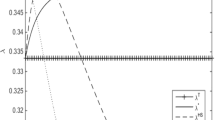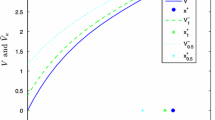Abstract
We study, in the framework of Back [Rev. Financial Stud. 5(3), 387–409 (1992)], an equilibrium model for the pricing of a defaultable zero coupon bond issued by a firm. The market consists of a risk-neutral informed agent, noise traders, and a market maker who sets the price using the total order. When the insider does not trade, the default time possesses a default intensity in the market’s view as in reduced-form credit risk models. However, we show that, in equilibrium, the modelling becomes structural in the sense that the default time becomes the first time that some continuous observation process falls below a certain barrier. Interestingly, the firm value is still not observable. We also establish the no expected trade theorem that the insider’s trades are inconspicuous.
Similar content being viewed by others
References
Artzner, P., Delbaen, F.: Default risk insurance and incomplete markets. Math. Finance 5, 187–195 (1995)
Back, K.: Insider trading in continuous time. Rev. Financial Stud. 5(3), 387–409 (1992)
Bielecki, T., Rutkowski, M.: Credit Risk: Modeling, Valuation and Hedging. Springer, New York (2002)
Black, F., Scholes, M.: The pricing of options and corporate liabilities. J. Political Economy 81, 637–654 (1973)
Çetin, U., Jarrow, R., Protter, P., Yıldırım, Y.: Modeling credit risk with partial information. Ann. Appl. Probab. 14, 1167–1178 (2004)
Cho, K.-H.: Continuous auctions and insider trading: uniqueness and risk aversion. Finance Stochastics 7, 47–71 (2003)
Duffie, D., Lando, D.: Term structure of credit spreads with incomplete accounting information. Econometrica 69, 633–664 (2001)
Duffie, D., Singleton, K.: Credit Risk: Pricing, Measurement, and Management. Princeton University Press, Princeton (2003)
Duffie, D., Singleton, K.: Modeling term structures of defaultable bonds. Rev. Financial Stud. 12, 687–720 (1999)
Duffie, D., Schroder, M., Skiadas, C.: Recursive valuation of defaultable securities and the timing of resolution of uncertainty. Ann. Appl. Probab. 6, 1075–1090 (1996)
Helwege, J., Turner, C.: The slope of the credit yield curve for speculative-grade issuers. J. Finance 54, 1869–1884 (1999)
Huang, J., Huang, M.: How much of the corporate-treasury yield spread is due to credit risk? Working paper, Cornell University. http://papers.ssrn.com/sol3/papers.cfm?abstract_id=307360 (2003)
Jarrow, R., Protter, P.: Structural versus reduced form models: a new information based perspective. J. Investment Manag. 2(2), 1–10 (2004)
Jarrow, R., Turnbull, S.: Credit risk: drawing the analogy, Risk Magazine 5(9) (1992)
Jarrow, R., Turnbull, S.: Pricing options on financial securities subject to credit risk. J. Finance 50, 53–86 (1995)
Jeulin, T.: Semi-Martingales et Grossissement d’une Filtration. Lecture Notes in Mathematics, vol. 833. Springer, Berlin (1980)
Lando, D.: Three essays on contingent claims pricing. Ph.D. thesis, Cornell University (1994)
Lando, D.: On Cox processes and credit risky securities. Rev. Derivatives Res. 2, 99–120 (1998)
Merton, R.: On the pricing of corporate debt: risk structure of interest rates. J. Finance 29, 449–470 (1974)
Revuz, D., Yor, M.: Continuous Martingales and Brownian Motion, 3rd edn. Springer, Berlin (1999)
Rogers, L.C.G., Williams, D.: Diffusions, Markov Processes and Martingales, vol. 2. Cambridge University Press, Cambridge (2000)
Author information
Authors and Affiliations
Corresponding author
Rights and permissions
About this article
Cite this article
Campi, L., Çetin, U. Insider trading in an equilibrium model with default: a passage from reduced-form to structural modelling. Finance Stoch 11, 591–602 (2007). https://doi.org/10.1007/s00780-007-0038-4
Received:
Accepted:
Published:
Issue Date:
DOI: https://doi.org/10.1007/s00780-007-0038-4




